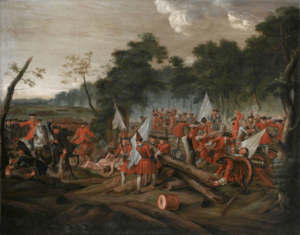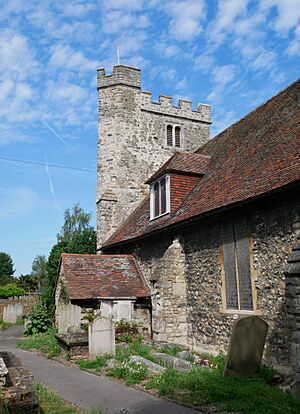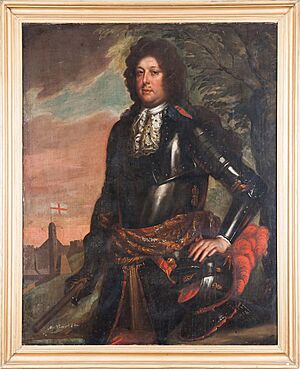Henry Withers facts for kids
Quick facts for kids
Henry Withers
|
|
|---|---|

Withers commanded a detachment of Allied troops at Malplaquet, one of the bloodiest battles of the century
|
|
| Member of Parliament for Queenborough |
|
| In office 1708–1710 |
|
| Governor of Sheerness | |
| In office 1706–1729 |
|
| Personal details | |
| Born | c. 1651 |
| Died | 11 November 1729 (aged 78) Greenwich, London |
| Resting place | Westminster Abbey |
| Nationality | English |
| Political party | Whig |
| Occupation | Soldier and politician |
| Military service | |
| Years of service | 1678-1729 |
| Rank | Lieutenant General |
| Unit | Lieutenant-Colonel, First Foot Guards |
| Commands | Commander of Foot, Flanders 1712 |
| Battles/wars | Franco-Dutch War Battle of Entzheim Monmouth Rebellion Sedgemoor Williamite War in Ireland The Boyne; Waterford; First Limerick Nine Years War Namur 1695 War of the Spanish Succession Schellenberg; Blenheim; Siege of Tournai; Malplaquet |
Henry Withers (around 1651 – 1729) was an important British army officer and politician. He started his military career in 1674 during the Franco-Dutch War. By 1707, he had become a Lieutenant General, a very high rank.
Withers was a close friend and colleague of the famous Duke of Marlborough. He fought in many major battles during the War of the Spanish Succession. These included the battles of Schellenberg and Blenheim in 1704. He also took part in the bloody Malplaquet in 1709.
Contents
Who Was Henry Withers?
Early Life and Family
We don't know much about Henry Withers' early life or where he came from. His funeral monument says he came from a military family. It also states he was 78 when he died, meaning he was born around 1651.
Henry Withers never married. He left his property to his sister Elizabeth and his close friend, Colonel Henry Disney. They shared a house in Greenwich, London. Colonel Disney arranged Withers' burial in Westminster Abbey, a very famous church.
A Poet's Tribute
The memorial for Henry Withers in Westminster Abbey has special lines of poetry. These lines were supposedly written by the famous poet Alexander Pope. Pope was a friend of both Withers and Disney.
Henry Withers' Military Career
Starting as a Soldier
Henry Withers likely began his career in 1674. He joined a British group of soldiers fighting for France during the Franco-Dutch War. Important officers like Percy Kirke and John Churchill (who later became the Duke of Marlborough) were also part of this group.
Even though England left the war in 1674, this group of soldiers fought at Entzheim. They had many casualties and were later disbanded.
Fighting for England
In 1678, England rejoined the war, this time with the Dutch Republic. Withers became a Lieutenant in a new regiment. The war ended before his regiment saw action.
Since military jobs were hard to find, he accepted a lower rank as an ensign. He moved to the Tangier Garrison in a regiment led by Percy Kirke.
The Monmouth Rebellion
When Tangier was left in 1684, Withers' regiment joined the larger army of King James II. They fought at the Battle of Sedgemoor in 1685. This regiment was known as Kirke's Lambs. They became famous for how harshly they treated captured rebels.
The Glorious Revolution and Ireland
In 1688, a big change happened in England called the Glorious Revolution. King James II was replaced by William III. Churchill and Kirke were among the first to support William.
In 1689, Withers went to Ireland with the army. He was still serving under Kirke. He fought at the Battle of the Boyne. He also helped capture Waterford and took part in the first Siege of Limerick.
War in Flanders
In April 1691, Withers' unit moved to Flanders (part of modern-day Belgium). They joined the Nine Years War.
Percy Kirke died in October 1691. Withers then found a new supporter in the Earl of Romney. Romney was the colonel of the First Foot Guards. In 1695, Romney made Withers a major in his regiment. Withers helped capture Namur later that year.
When the war ended in 1697 with the Peace of Ryswick, Withers was a Lieutenant-Colonel. He was effectively in charge of the regiment because Romney was often away.
Withers in Politics and Major Wars
The War of the Spanish Succession
In 1701, the War of the Spanish Succession began. The army grew again, and Withers became a Brigadier-General in 1702. He served under the Duke of Marlborough in Flanders and the Rhineland.
In 1704, Marlborough became the colonel of the First Foot Guards. Withers continued as its Lieutenant-Colonel and was promoted to Major General. He led a group of soldiers at Schellenberg in July and fought at Blenheim in August.
A Governor and a Member of Parliament
In 1706, Marlborough helped Withers become Governor of Sheerness. This was an important position that Withers held until he died in 1729.
This role also helped him get elected as a MP for Queenborough in 1708. He was part of the Whig political group. However, he spent little time in Parliament.

The Battle of Malplaquet
By 1709, Withers was back in Flanders. He was wounded during the siege of Tournai. He recovered in time to lead more soldiers to the main army at Malplaquet. The Duke of Marlborough even waited for Withers' troops to arrive before starting his attack on September 11.
Withers' troops arrived late, so they played a smaller role in the battle. However, their arrival made the French army think the Allied forces were stronger, causing them to retreat.
Later Years and Retirement
Even though they had a long history, Withers sided with Queen Anne when she had disagreements with Marlborough. He returned from Flanders in 1710. He did not run for election again that year.
Withers was on good terms with Henry St. John, a powerful government official. In 1712, Marlborough was replaced as army commander. Withers returned to Flanders to lead the infantry.
When Queen Anne died in 1714, some hoped Withers would support James Francis Edward Stuart, who wanted to be king. But Withers strongly supported the new king, George I. He kept his job at Sheerness.
Withers remained a Lieutenant-Colonel but never became a full colonel. He lived a quiet life in Greenwich until he died in 1729.
Images for kids





